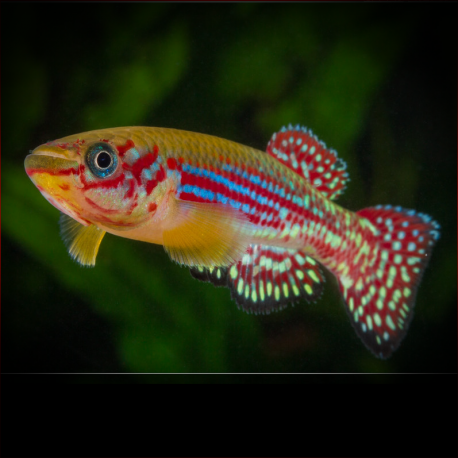More info
Datasheet
| Maximum Size | 4.7cm / 1.85inches |
| Temperature | 22°C / 71.60°F - 26°C / 78.80°F |
| Hardness | 1.01dgH / 18ppm - 15.02dgH / 268ppm |
| pH | 6.0-7.5 |
General Description
Fundulopanchax Gresensi, a member of the Cyprinodontiformes order under the Nothobranchiidae family, is a small fish species reaching a maximum size of 4.7cm. This species is found in shallow, swampy sections of forested streams in western Cameroon and is at risk due to potential deforestation in its habitat.
Aquarium Setup
When creating an aquarium environment for Fundulopanchax Gresensi, it is essential to provide a cover for the tank as they are known to be skilled jumpers. The setup should include aquatic plants, wool mops, and air-powered, sponge-type filtration systems to protect the eggs and fry. While lighting is optional, filamentous algae growth should be allowed in the tank. Water conditions should range between a hardness of 18-268ppm, a pH of 6.0-7.5, and a temperature of 22-26°C.
Behaviour
Fundulopanchax Gresensi displays typical behavior for its species, showing tendencies towards exploration and territoriality within its habitat. They are known to be active swimmers, especially in the presence of suitable tank mates and a well-suited environment.
Feeding and Diet
In their natural habitat, Fundulopanchax Gresensi primarily feeds on small invertebrates and insect larvae. In a captive environment, they can be fed a diet consisting of high-quality flake foods, live or frozen brine shrimp, bloodworms, and small invertebrates to ensure proper nutrition and health.
Reproduction & Dimorphism
This species reproduces through the egg-laying method. The female will scatter eggs among plants or suitable substrate, while the male fertilizes them. Males are often more colorful compared to females, displaying vibrant hues of red, blue, or yellow, especially during the breeding season.
Habitat and Distribution
Fundulopanchax Gresensi is known to be native only to specific regions near the villages of Takwai I and II, Atebong Wire, and Edjuingan in western Cameroon. It is primarily found in the Bagwor and Mack river systems, both of which are tributaries within the upper Cross River basin. The species thrives in shallow, forested streams, some of which may dry out seasonally, posing potential threats due to habitat loss from deforestation.

